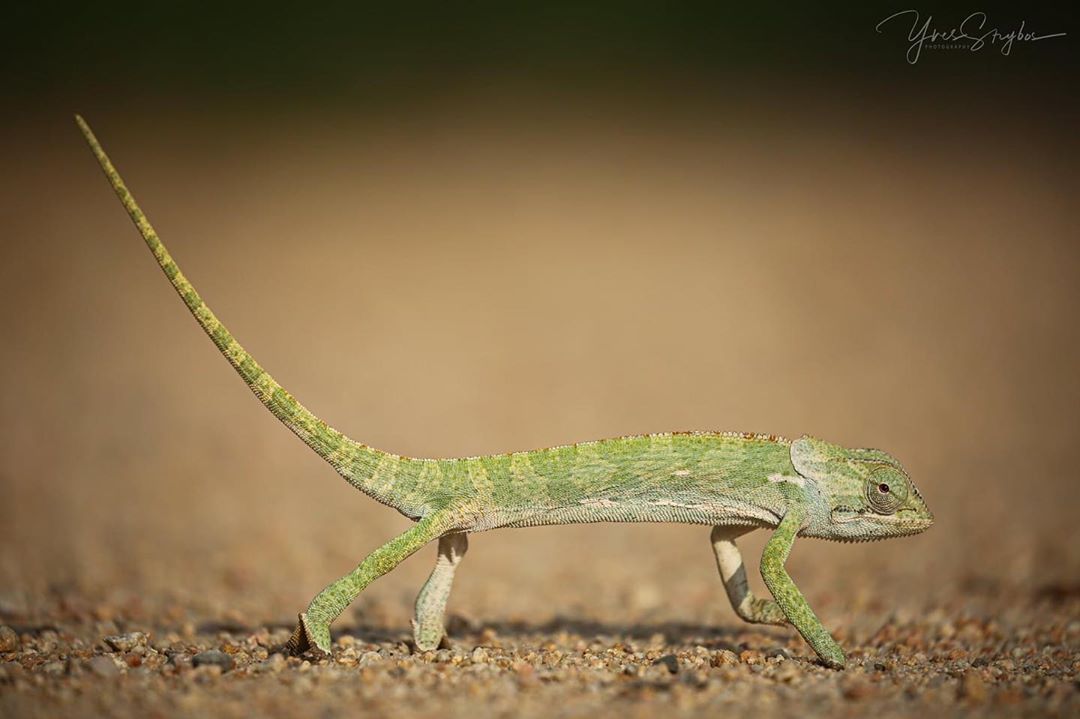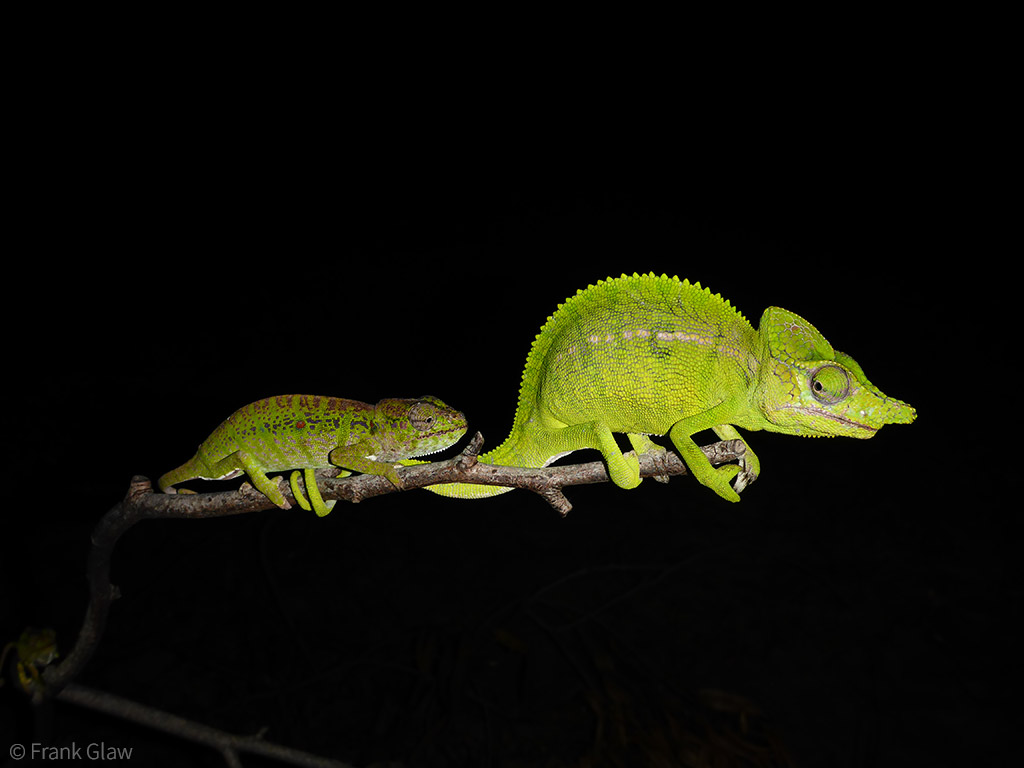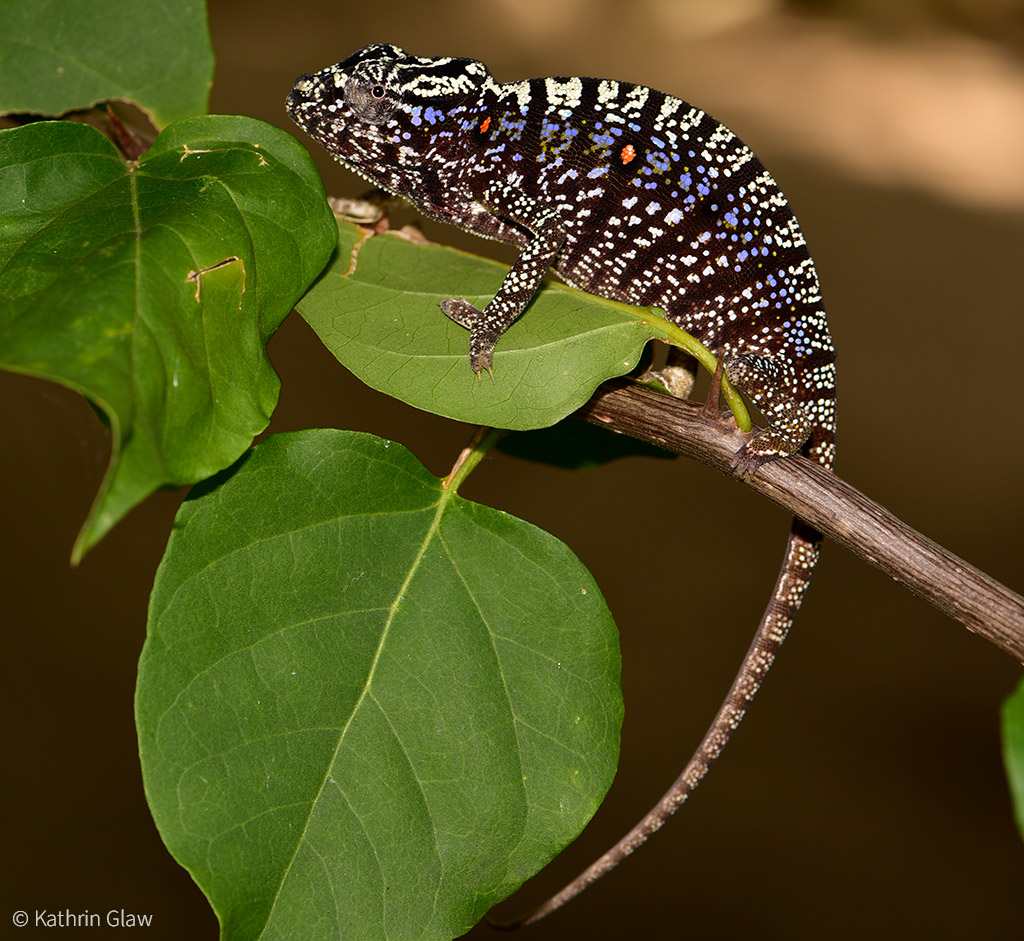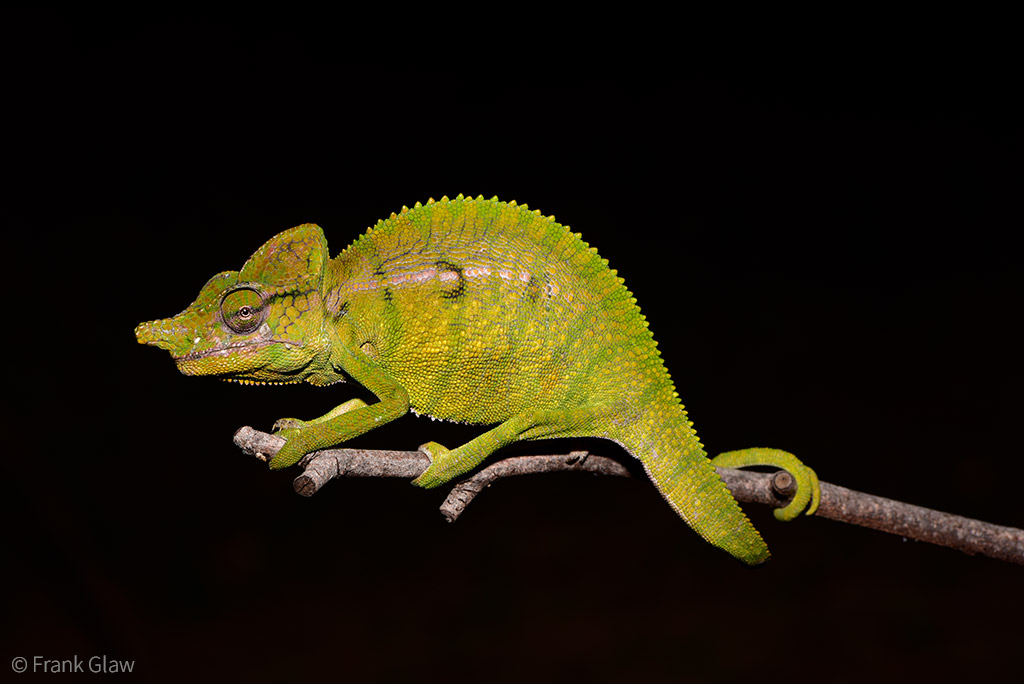Got it from Borderline!
Chameleon
Moderator: Klipspringer
- Richprins
- Committee Member
- Posts: 75969
- Joined: Sat May 19, 2012 3:52 pm
- Location: NELSPRUIT
- Contact:
Re: Chameleon
Got it from Borderline!
Please check Needs Attention pre-booking: https://africawild-forum.com/viewtopic.php?f=322&t=596
- Mel
- Global Moderator
- Posts: 28224
- Joined: Sat May 19, 2012 12:31 pm
- Country: Germany
- Location: Föhr
- Contact:
Re: Chameleon
Still 


God put me on earth to accomplish a certain amount of things. Right now I'm so far behind that I'll never die.
- Lisbeth
- Site Admin
- Posts: 67396
- Joined: Sat May 19, 2012 12:31 pm
- Country: Switzerland
- Location: Lugano
- Contact:
Re: Chameleon
Wow!!!!
I wonder if the mother helps the off-spring to find food
I wonder if the mother helps the off-spring to find food
"Education is the most powerful weapon which you can use to change the world." Nelson Mandela
The desire for equality must never exceed the demands of knowledge
The desire for equality must never exceed the demands of knowledge
- Lisbeth
- Site Admin
- Posts: 67396
- Joined: Sat May 19, 2012 12:31 pm
- Country: Switzerland
- Location: Lugano
- Contact:
Re: Chameleon
Those also come out when the roads are not empty 
08.02.2020
08.02.2020
"Education is the most powerful weapon which you can use to change the world." Nelson Mandela
The desire for equality must never exceed the demands of knowledge
The desire for equality must never exceed the demands of knowledge
- Lisbeth
- Site Admin
- Posts: 67396
- Joined: Sat May 19, 2012 12:31 pm
- Country: Switzerland
- Location: Lugano
- Contact:
Re: Chameleon
Did you know...

The world's LARGEST & SMALLEST chameleon species in the world are found in Madagascar. The dwarf leaf chameleon measures just 15mm and can stand on the head of a match, while the Parson's chameleon (Calumma parsonii) measures 69.5cm in length (the size of a house cat).

The world's LARGEST & SMALLEST chameleon species in the world are found in Madagascar. The dwarf leaf chameleon measures just 15mm and can stand on the head of a match, while the Parson's chameleon (Calumma parsonii) measures 69.5cm in length (the size of a house cat).
"Education is the most powerful weapon which you can use to change the world." Nelson Mandela
The desire for equality must never exceed the demands of knowledge
The desire for equality must never exceed the demands of knowledge
- Richprins
- Committee Member
- Posts: 75969
- Joined: Sat May 19, 2012 3:52 pm
- Location: NELSPRUIT
- Contact:
Re: Chameleon

Kruger Sightings
@LatestKruger
January 2020
Cama Cama Chameleon. Take time to appreciate the smaller creatures in life! Seen in Biyamiti camp in the Kruger.
Tinged by @yvesstrybos
Please check Needs Attention pre-booking: https://africawild-forum.com/viewtopic.php?f=322&t=596
- Lisbeth
- Site Admin
- Posts: 67396
- Joined: Sat May 19, 2012 12:31 pm
- Country: Switzerland
- Location: Lugano
- Contact:
Re: Chameleon
“Lost” species of chameleon found in hotel gardens
Posted on November 16, 2020 by Team Africa Geographic

Male and female Voeltzkow’s chameleon
The last official sighting of the Voeltzkow’s chameleon (Furcifer voeltzkowi) was in 1913 in Madagascar, earning it a spot on the Top 25 Most Wanted taxon in Global Wildlife Conservation’s Search for Lost Species initiative. A two-week expedition to north-western Madagascar resulted in not only the rediscovery of this unique chameleon but the very first description of the colourful females.
The Voeltzkow’s chameleon was first described from a male specimen collected by German biologist Alfred Voeltzkow in 1893. Little was known about this cryptic species, and no female specimens had ever been described. The expedition to find the Voeltzkow’s chameleon ran from the 25th of March to the 3rd of April 2018 (during Madagascar’s rainy season) and, according to the biologists, yielded nothing but frustration until the final few days. Angeluc Razafimanantsoa, a professional Malagasy guide and member of the expedition, was the first to spot one of the mysterious chameleons in the wild gardens of Chez Madame Chabaud hotel.
One explanation behind the difficulty in finding the Voeltzkow’s chameleon lies in its close relationship to the Labord’s chameleon (Furcifer labordi), which lives for just a few months every year. The eggs of the Labord’s chameleon hatch in November and the young chameleons reach sexual maturity extremely rapidly (within two months). Once the mature individuals have had the opportunity to mate and lay their eggs in January and February, they will die just a month or two later. Biologists believe it highly likely that the Voeltzkow’s chameleon follows a similar lifecycle which has made finding them a challenging task. This has been exacerbated by the fact that adult chameleons are active during Madagascar’s rainy season, where parts of the island become almost inaccessible.

Female Voeltzkow’s chameleon
Nevertheless, the team managed to find three males and 15 females – numbers which, according to the researchers, suggest the possibility of a healthy population for a short-lived species. They also discovered just how colourful the females, particularly gravid (pregnant) females, can be. The newly released paper on the discovery describes how the Voeltzkow’s chameleon is a sexually dimorphic species, with the males observed to be significantly less colourful than their female counterparts (though both are primarily green in colour when relaxed). Like all chameleons, the female Voeltzkow’s chameleons change colour according to their moods, particularly when antagonized in some way, displaying vivid and highly variable colour patterns of purple, orange, red, green, black, and white.
The newly published study released in Salamandra, the German Journal of Herpetology, the researchers detail the findings of the 2018 expedition, providing the first new information on the little animal’s genetics, morphology, and behaviour in over a century.
Madagascar is home to around half the world’s chameleon species, over 100 of which are endemic. Of these Malagasy chameleons, 52% are threatened, and 70% are considered threatened or near-threatened. Habitat loss and deforestation are some of the main threats facing most of the island’s endemic wildlife – it is believed that less than 10% of Madagascar’s natural forests remain.
“The Voeltzkow’s chameleon is a powerful flagship species for conservation in the region,” said Carlos Zanotelli, a member of the 2018 expedition. “It is imperative that we protect nature and treat natural habitats as if we would like to live there. Only in this way can we ensure the future of the incredible species, like the Voeltzkow’s chameleon, we share this planet with.”

Male Voeltzkow’s chameleon
Along with the rediscovery of the Somali sengi announced earlier this year, the Voeltzkow’s chameleon is the sixth species on the Global Wildlife Conservation’s 25 most wanted list to be confirmed as having been rediscovered. As the study on the Voeltzkow’s chameleon succinctly explains, “rediscoveries of “lost” species are important as they provide crucial data for conservation measures and bring some hope amidst the biodiversity crisis.”
Posted on November 16, 2020 by Team Africa Geographic

Male and female Voeltzkow’s chameleon
The last official sighting of the Voeltzkow’s chameleon (Furcifer voeltzkowi) was in 1913 in Madagascar, earning it a spot on the Top 25 Most Wanted taxon in Global Wildlife Conservation’s Search for Lost Species initiative. A two-week expedition to north-western Madagascar resulted in not only the rediscovery of this unique chameleon but the very first description of the colourful females.
The Voeltzkow’s chameleon was first described from a male specimen collected by German biologist Alfred Voeltzkow in 1893. Little was known about this cryptic species, and no female specimens had ever been described. The expedition to find the Voeltzkow’s chameleon ran from the 25th of March to the 3rd of April 2018 (during Madagascar’s rainy season) and, according to the biologists, yielded nothing but frustration until the final few days. Angeluc Razafimanantsoa, a professional Malagasy guide and member of the expedition, was the first to spot one of the mysterious chameleons in the wild gardens of Chez Madame Chabaud hotel.
One explanation behind the difficulty in finding the Voeltzkow’s chameleon lies in its close relationship to the Labord’s chameleon (Furcifer labordi), which lives for just a few months every year. The eggs of the Labord’s chameleon hatch in November and the young chameleons reach sexual maturity extremely rapidly (within two months). Once the mature individuals have had the opportunity to mate and lay their eggs in January and February, they will die just a month or two later. Biologists believe it highly likely that the Voeltzkow’s chameleon follows a similar lifecycle which has made finding them a challenging task. This has been exacerbated by the fact that adult chameleons are active during Madagascar’s rainy season, where parts of the island become almost inaccessible.

Female Voeltzkow’s chameleon
Nevertheless, the team managed to find three males and 15 females – numbers which, according to the researchers, suggest the possibility of a healthy population for a short-lived species. They also discovered just how colourful the females, particularly gravid (pregnant) females, can be. The newly released paper on the discovery describes how the Voeltzkow’s chameleon is a sexually dimorphic species, with the males observed to be significantly less colourful than their female counterparts (though both are primarily green in colour when relaxed). Like all chameleons, the female Voeltzkow’s chameleons change colour according to their moods, particularly when antagonized in some way, displaying vivid and highly variable colour patterns of purple, orange, red, green, black, and white.
The newly published study released in Salamandra, the German Journal of Herpetology, the researchers detail the findings of the 2018 expedition, providing the first new information on the little animal’s genetics, morphology, and behaviour in over a century.
Madagascar is home to around half the world’s chameleon species, over 100 of which are endemic. Of these Malagasy chameleons, 52% are threatened, and 70% are considered threatened or near-threatened. Habitat loss and deforestation are some of the main threats facing most of the island’s endemic wildlife – it is believed that less than 10% of Madagascar’s natural forests remain.
“The Voeltzkow’s chameleon is a powerful flagship species for conservation in the region,” said Carlos Zanotelli, a member of the 2018 expedition. “It is imperative that we protect nature and treat natural habitats as if we would like to live there. Only in this way can we ensure the future of the incredible species, like the Voeltzkow’s chameleon, we share this planet with.”

Male Voeltzkow’s chameleon
Along with the rediscovery of the Somali sengi announced earlier this year, the Voeltzkow’s chameleon is the sixth species on the Global Wildlife Conservation’s 25 most wanted list to be confirmed as having been rediscovered. As the study on the Voeltzkow’s chameleon succinctly explains, “rediscoveries of “lost” species are important as they provide crucial data for conservation measures and bring some hope amidst the biodiversity crisis.”
"Education is the most powerful weapon which you can use to change the world." Nelson Mandela
The desire for equality must never exceed the demands of knowledge
The desire for equality must never exceed the demands of knowledge
- Richprins
- Committee Member
- Posts: 75969
- Joined: Sat May 19, 2012 3:52 pm
- Location: NELSPRUIT
- Contact:
Re: Chameleon
Please check Needs Attention pre-booking: https://africawild-forum.com/viewtopic.php?f=322&t=596
- Richprins
- Committee Member
- Posts: 75969
- Joined: Sat May 19, 2012 3:52 pm
- Location: NELSPRUIT
- Contact:
Re: Chameleon
'We had goosebumps': Wits scientist finds tiny, rare chameleons clinging to survival
By TimesLIVE - 03 August 2021 - 09:37
Chapman’s pygmy chameleon uses its camouflage to blend in with dry leaves on the forest floor.

Supplied
When researchers descended on small patches of rainforest in Malawi, they weren't particularly hopeful of finding what they were looking for — a tiny chameleon feared to be extinct in the wild.
But, to their surprise, not only did they find the Chapman’s pygmy chameleon, they found the tiny creature at all three of their surveillance sites.
Wits University honorary researcher Prof Krystal Tolley, who lead-authored a study on the chameleon, which was published on Tuesday, said the team couldn't contain their excitement when they found the animal.
“We found the first chameleon in the transition zone on the forest edge, where there are some trees but mostly maize and cassava plants,” said Tolley, speaking of their trip to Malawi.
“When we found it, we had goosebumps and just started jumping around. While we were excited to find these chameleons still clinging to survival, we have no idea how much longer these populations will persist in these tiny patches of forest.”
In 2014, a conservation assessment by Tolley led to the listing of Chapman’s pygmy chameleon as “critically endangered” on the International Union for Conservation of Nature (IUCN) Red List of Threatened Species, making it one of the world’s rarest chameleon species.
Comparing current-day satellite images of the species’ known habitat with those taken in the 1980s revealed dramatic forest loss. What remained had become fragmented — small patches of forest, cut off from each other. They estimate that the forest — and with it, chameleon numbers — has shrunk by 80% since the 1980s.
Faced with fears that species may have been relegated to the chasm of extinction, Tolley led a team to find out if the chameleons still survive in the wild.
The team, comprising of researchers from the South African National Biodiversity Institute and the Museums of Malawi, turned to the crowdfunding website, RocketHub, to raise money for the project. Concerned citizens responded to the appeal, donating more than R80,000 to the campaign, which was sufficient to fund surveys of three forest patches in which the species was thought to most likely still occur.
To investigate the genetic health of these populations, Tolley collected tissue samples from chameleons in each forest patch. Genetic analyses suggested that these populations are unable to move between forest patches to breed because of the highly fragmented habitat. Without a healthy level of gene flow between populations, genetic diversity will be lost over time, posing another serious threat to the species’ survival.
“The loss of forest habitat requires urgent conservation action, including halting of forest destruction and recovery of habitat to promote connectivity between forest patches,” says Tolley. “Without action, the species may reach a point from which it cannot return.”
As a measure to protect the species’ remaining habitat, the researchers suggest that the forest patches in which the chameleons live be incorporated into the nearby Matandwe Forest Reserve so that it can be proclaimed as a Key Biodiversity Area, along with introducing strong measures to ensure its protection. They also recommend regular and thorough surveys of the chameleon populations to monitor their numbers and genetic health.
“They are little, gentle creatures,” says Tolley. “I feel sad when I think about what’s happening to them — what we are doing to their habitat. They are really just helpless victims.”
Chapman’s pygmy chameleon (Rhampholeon chapmanorum) is a tiny, rare chameleon found in the rainforests of southern Malawi. Adults of the species grow to only six centimetres in length, and unlike most chameleons that live above the ground, these diminutive reptiles live on the forest floor where they blend in with dried leaves. The species was described by scientists only in 1992, but severe destruction of the forest habitat for agricultural growth of maize and cassava has left the survival of the species on uncertain terms.
TimesLIVE
https://www.sowetanlive.co.za/news/sout ... -survival/
By TimesLIVE - 03 August 2021 - 09:37
Chapman’s pygmy chameleon uses its camouflage to blend in with dry leaves on the forest floor.
Supplied
When researchers descended on small patches of rainforest in Malawi, they weren't particularly hopeful of finding what they were looking for — a tiny chameleon feared to be extinct in the wild.
But, to their surprise, not only did they find the Chapman’s pygmy chameleon, they found the tiny creature at all three of their surveillance sites.
Wits University honorary researcher Prof Krystal Tolley, who lead-authored a study on the chameleon, which was published on Tuesday, said the team couldn't contain their excitement when they found the animal.
“We found the first chameleon in the transition zone on the forest edge, where there are some trees but mostly maize and cassava plants,” said Tolley, speaking of their trip to Malawi.
“When we found it, we had goosebumps and just started jumping around. While we were excited to find these chameleons still clinging to survival, we have no idea how much longer these populations will persist in these tiny patches of forest.”
In 2014, a conservation assessment by Tolley led to the listing of Chapman’s pygmy chameleon as “critically endangered” on the International Union for Conservation of Nature (IUCN) Red List of Threatened Species, making it one of the world’s rarest chameleon species.
Comparing current-day satellite images of the species’ known habitat with those taken in the 1980s revealed dramatic forest loss. What remained had become fragmented — small patches of forest, cut off from each other. They estimate that the forest — and with it, chameleon numbers — has shrunk by 80% since the 1980s.
Faced with fears that species may have been relegated to the chasm of extinction, Tolley led a team to find out if the chameleons still survive in the wild.
The team, comprising of researchers from the South African National Biodiversity Institute and the Museums of Malawi, turned to the crowdfunding website, RocketHub, to raise money for the project. Concerned citizens responded to the appeal, donating more than R80,000 to the campaign, which was sufficient to fund surveys of three forest patches in which the species was thought to most likely still occur.
To investigate the genetic health of these populations, Tolley collected tissue samples from chameleons in each forest patch. Genetic analyses suggested that these populations are unable to move between forest patches to breed because of the highly fragmented habitat. Without a healthy level of gene flow between populations, genetic diversity will be lost over time, posing another serious threat to the species’ survival.
“The loss of forest habitat requires urgent conservation action, including halting of forest destruction and recovery of habitat to promote connectivity between forest patches,” says Tolley. “Without action, the species may reach a point from which it cannot return.”
As a measure to protect the species’ remaining habitat, the researchers suggest that the forest patches in which the chameleons live be incorporated into the nearby Matandwe Forest Reserve so that it can be proclaimed as a Key Biodiversity Area, along with introducing strong measures to ensure its protection. They also recommend regular and thorough surveys of the chameleon populations to monitor their numbers and genetic health.
“They are little, gentle creatures,” says Tolley. “I feel sad when I think about what’s happening to them — what we are doing to their habitat. They are really just helpless victims.”
Chapman’s pygmy chameleon (Rhampholeon chapmanorum) is a tiny, rare chameleon found in the rainforests of southern Malawi. Adults of the species grow to only six centimetres in length, and unlike most chameleons that live above the ground, these diminutive reptiles live on the forest floor where they blend in with dried leaves. The species was described by scientists only in 1992, but severe destruction of the forest habitat for agricultural growth of maize and cassava has left the survival of the species on uncertain terms.
TimesLIVE
https://www.sowetanlive.co.za/news/sout ... -survival/
Please check Needs Attention pre-booking: https://africawild-forum.com/viewtopic.php?f=322&t=596
- PJL
- Posts: 2825
- Joined: Mon Jan 13, 2014 10:12 am
- Country: South Africa
- Location: Port Elizabeth
- Contact:
Re: Chameleon
unlike most chameleons that live above the ground, these diminutive reptiles live on the forest floor where they blend in with dried leaves.
Jumping around might not have been in the best interests of conservation“When we found it, we had goosebumps and just started jumping around.”


